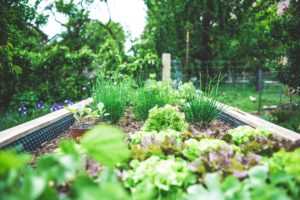Are you looking for ideas, tips, and inspiration for how to homeschool preschool? If so, you’re in the right place. I loved homeschooling preschool, and I hope you will as well. With some planning and preparation, you’ll create a homeschool preschool that will not only meet your child’s needs, but that you’ll feel great about as a homeschool mom.
Let’s get started!
Create the Preschool Experience You Want
You should know that it’s important to allow your homeschool preschool to be what YOU want it to be. There’s no need to try and replicate the schedule of the local preschool down the street.
There may be aspects of a formal preschool environment that appeal to you. Feel free to include those aspects in your preschool. However, don’t believe there is one right way to do this. Nothing could be further from the truth!
At this stage, your child learns primarily through playing, exploring, and everyday life activities, like helping with laundry or cooking. By focusing on creating a rich learning environment, you can trust your child is gaining the skills and knowledge they need. As Charlotte Mason believed in her approach to educating a child, “Education is an atmosphere, a discipline, and a life.”
As you pay attention to the things your child shows interest in, you’ll be able to naturally pursue those interests even further. This is a perk of homeschooling preschool!
Establish a Daily Preschool Routine
Young children thrive on consistency and predictability. This doesn’t mean you need to have a schedule that is written in stone hour by hour. However, a routine provides a familiar expectation of what will typically happen each day.
Routines are also helpful in minimizing the number of decisions you have to make on any given day. Considering we make thousands of decisions each day, any chance to lessen decision fatigue is a win!
Within your preschool routine, try to include a balance of structured activities, free play, outdoor time, and rest. However, be flexible and willing to adapt that routine to make it work for you.
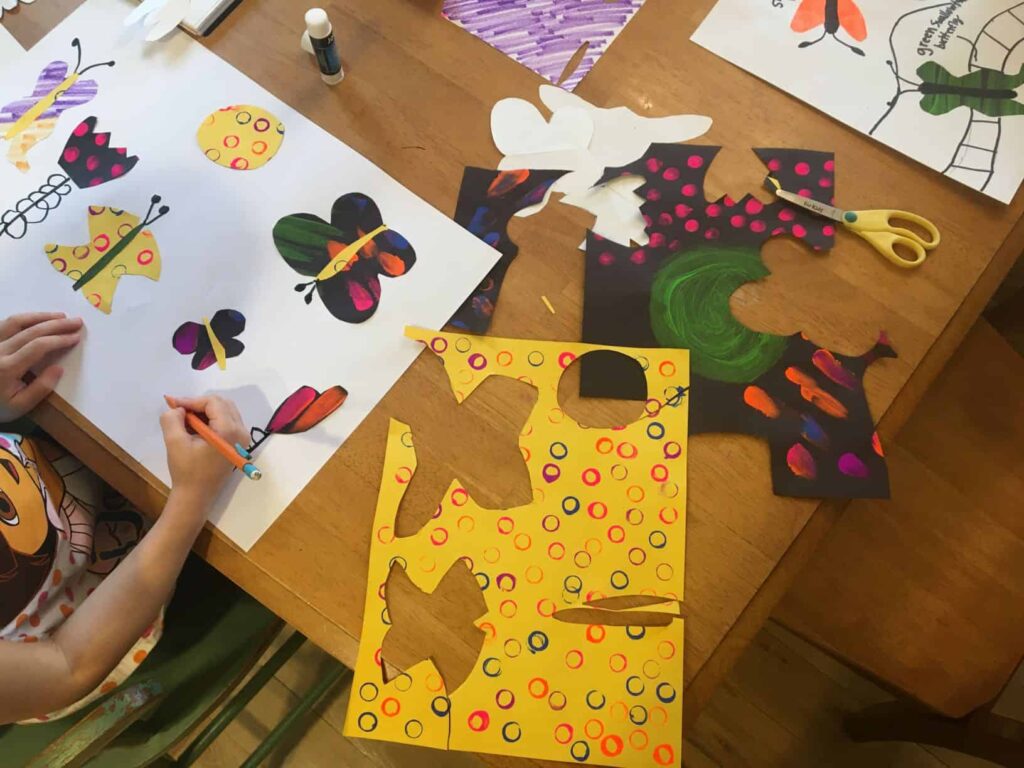
Our typical day during the preschool years looked something like this:
- Wake up
- Breakfast
- Play activities (indoor or outdoor)
- Snack
- Books/Play/Art/Nap (depending on age)
- Lunch
- Storytime
- Nap
- Snack
- Play
- Quiet time
- Dinner
- Family time/play
- Bedtime routine
- Bed
Believe it or not, a routine is also helpful for you, mom. All humans are creatures of habit. We typically like to do the same things day after day. Thus, having a routine can be great when it comes to your self-care as well.
When you know that naptime happens shortly after lunch, you can look forward to this opportunity for your own nap, a chance to exercise, or a reading break in the recliner.
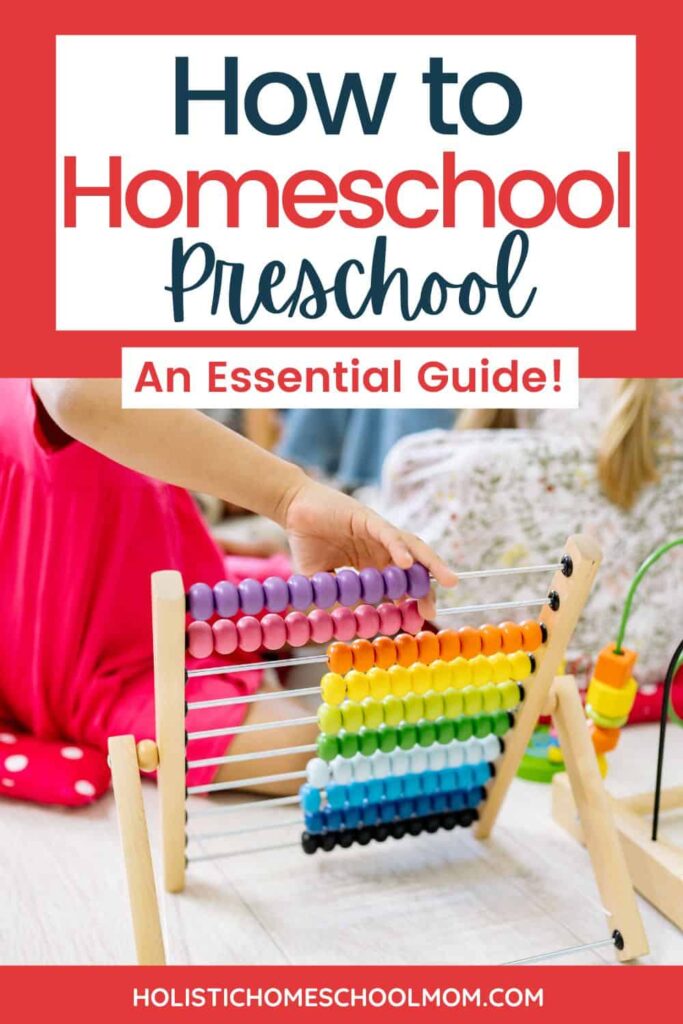
Create Child-Friendly Learning Spaces
Throughout our home, I created various spaces conducive to homeschooling. If your child has older siblings, you probably already have these spaces. If you’re just starting your homeschooling journey, it’s helpful to create these child-friendly learning areas.
Ideas include a cozy reading corner with a beanbag chair and a basket of books, or a child-sized table and chairs for painting, drawing, playdoh, etc.
Create Preschool Spaces Using What You Already Have
I remember wishing I had a playroom or homeschool room to contain all the kid-related things. I quickly had to let that thinking go. In reality, preschoolers love to be where you are. This is where real life happens anyways, isn’t it?
They watch you make breakfast and wash the dishes. They see you feed and brush the dog. Sure, they may be playing off to the side, but they are aware of what mom happens to be doing too!
It’s easy to turn what you already have into learning spaces. Don’t feel the need to order a bunch of furniture and supplies.
For example, our living room coffee table had a shelf underneath where I housed toys and puzzles in attractive bins. A large area rug on our wooden floors was perfect for playing on hands and knees.
In our dining room, I had a wooden cabinet with doors. We called this the craft cabinet. It housed all our art supplies, from paints and paper to markers, crayons, scissors, and glue.
In the backyard, a patio with a sand/water table provided outdoor play activities. Our garage held tricycles, balls, bubbles, etc.
In the bedroom, my preschoolers always had a comfy chair to read books or be rocked by mom or dad; baskets containing age-appropriate books; a cozy bed for afternoon naps, and a floor rug for comfortable play (we have wooden floors).
Helpful Supplies for Homeschooling Preschool
When preparing to homeschool preschool, it’s helpful to have some basic supplies on hand. Here’s a list to get you started:
- Crayons
- Colored pencils
- Wooden/foam letters and numbers
- Pencils
- Washable paints
- Paintbrushes
- Markers
- Scissors
- Glue/glue sticks
- Construction paper
- Age-appropriate books
- Bins/baskets for books
- Puzzles
- Educational toys
- Playdoh
- Learning-themed music CDs or playlists
These items would also be helpful additions to your homeschool preschool, some of which you might own already:
- TV, computer, or Ipad
- Dress-up clothes
- Sand/Water table
- Outdoor playset
- Trampoline
- Tricycle
- Scooter
- Bubbles
- Balls
- Water sprinkler
- Sidewalk chalk
- Art supply cart (everything in one place!)
- Quiet time bins

Follow Your Preschool Child’s Interests
One of the most important things you can do as a homeschool mom is to be aware of your child’s interests.
What’s capturing their attention? What are they excited about?
If they show interest in animals you can incorporate books about animals, visit the zoo, or even care for a new pet (hamster, anyone?). My boys loved construction equipment and other large trucks. Once I realized this great fascination, I created additional learning experiences.
Here’s what this looked like:
- Borrowing books from the library about construction equipment, fire trucks, semi-trucks, etc.
- Visiting Touch a Truck events in the community
- Purchasing related toys or requesting those from grandparents for Christmas
- Walking down the street to watch local construction workers
- Stopping the car to watch a digger or grader in action
- Watching kid videos about all different types of construction equipment, garbage trucks, fire trucks, etc.
- Printing out related coloring pages
Provide Hands-On Learning Experiences
Preschoolers learn best through hands-on experiences. As much as possible, use everyday activities to teach important skills. Involve your child in cooking and baking, gathering ingredients, and measuring.
Some of the easiest things to make in the kitchen with young kids are single-bowl recipes like cakes, cookies, or brownies. Other child-friendly foods they can assist with easily are items like popsicles, pancakes, and sandwiches.
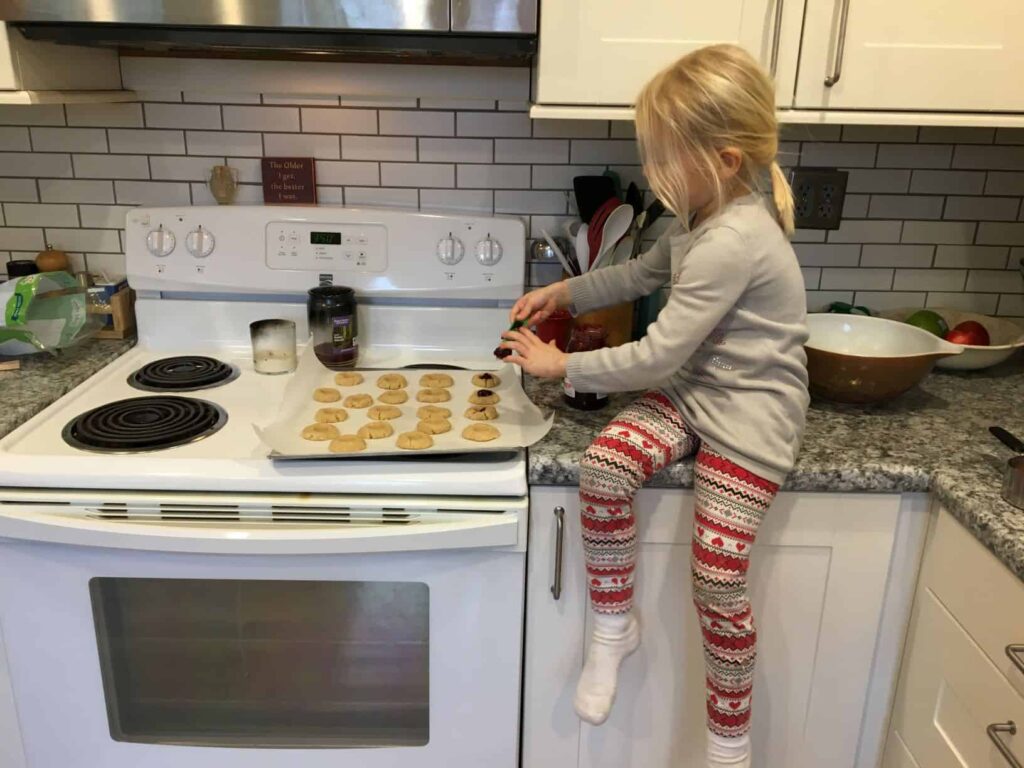
Additionally, let them help with household chores, encouraging them to sort laundry, match socks, or set the table, which develops fine motor skills and responsibility. More simple activities around the home that are perfect for young kids include working in the garden, watering flowers or plants, dusting, or feeding pets.
You can find many printable chore checklists online geared for this age group. A daily chore checklist is a wonderful addition to your preschooler’s daily routine!
You might also find the post How to Use Reward Charts in Your Homeschool helpful for chores.
What Subjects Should I Teach My Preschooler?
When considering how to homeschool preschool, you will want to focus on a variety of subjects for the growth and development of your child.
Here are some subjects to consider:
- Arts/crafts
- Music
- Science/nature
- Life skills
- Social skills
- Character/Bible
- Language/literacy
- Social studies
- Fine/gross motor skills
While this list sounds formal, there’s no need to use it as a checklist. Here’s an imaginary example of a homeschool preschool day that would encompass these activities comfortably and naturally:
After breakfast, your child brushes her teeth, her hair and gets dressed for the day. She puts away some clean laundry (life skills).
Afterward, you complete a simple craft while listening to classical music (art and music). It’s a nice day so you take a walk outside, observing nature and stopping to explore interesting bugs (motor skills and nature).
While walking, you instruct your child how to cross the street safely (life skills). You might discuss a community helper as you go. For example, discussing how a police officer works to keep your neighborhood safe, etc. (social studies).
Perhaps you encounter a neighbor walking towards you with their dog. You suggest she might pet the dog, but to ask the owner first. You model greeting the neighbor kindly, and your child asks to pet the dog (social skills, character, life skills).
Once you return home, you make lunch together (life skills). While you eat, you play a Bible story video on YouTube (Bible/character). After lunch, you read picture books about dolphins and the alphabet (language/literacy, science).
You get the picture.
Imagine day after day of investing in your child in these fantastic, yet natural ways. This is an amazing homeschool preschool experience! You can be confident that your child is learning and growing every single day.

Read Lots and Lots of Books Together
Reading to your preschooler is one of the BEST activities you can include in your homeschool preschool. I feel like I can’t stress this aspect enough. It’s important to have lots of books on various topics available.
Make reading a daily ritual in your homeschool. Set aside a specific time for reading together. I typically kept curated baskets of picture books in different locations around the house. When it was reading time, I would select a book or two, and my child chose a few as well.
Honestly, some of my favorite memories with my kids involve reading picture books on our porch swing. In the afternoons, when I started running low on energy and patience, I looked forward to this time to sit down and chill.
How Do I Find the Best Books for My Preschooler?
To find the best books for your preschooler, consider their interests, age-appropriate content, and educational value. You can visit the local library and ask for recommendations from librarians. They can be super-helpful when trying to locate books about specific topics.
You can also find online book reviews, lists, and recommendations for this age group. Sometimes I pulled books off the shelf at the library, but I also wanted to ensure I was reading the most excellent books I could.
Here are some resources I utilize for finding the best books for my kids:
- Honey for a Child’s Heart by Gladys Hunt
- The Read Aloud Handbook by Jim Trelease
- The Read-Aloud Family by Sarah Mackenzie
- Give Your Child the World by Jamie C. Martin
- Books Children Love by Elizabeth Wilson
- The Read Aloud Revival book lists
- The Best Children’s Books
What If My Preschooler Struggles to Sit Still?
Of course, not every little one likes to sit still. This often becomes most obvious when you sit down to read books. While you can cultivate this over time, some kids will still need something to fidget with.
It’s okay to let your kids play quietly while you read aloud. You can also pair read-aloud time with snack time.
Remember to consider your child’s attention span. Start with one book, gradually including more as they grow accustomed to the process. You want to keep this time a positive experience so they have pleasant associations with read-aloud time.

Socialization in the Preschool Years
The concept of socialization can be a hot topic in the homeschool world. People often question how a child could thrive if they aren’t around other children their age all day long.
Firstly, I encourage you to research homeschooling and socialization. Many excellent articles address common misunderstandings about this.
Secondly, it’s a great and normal for your kids to want to interact with other kids. They may already have siblings in the home, which provides them with a built-in experience.
If not, however, opportunities like these can provide interaction with other kids:
- playdates with friends
- participation in a local church that offers kids’ activities
- visits to the park
- joining a homeschool co-op
- library story time
- children’s museums
Why I Don’t Stress About Socialization
I didn’t stress about the concept of socialization when I had preschoolers, and I still don’t with my older children. You have plenty of opportunities in life to model for your kids and coach your kids about how to interact with people: grandparents, neighbors, children, strangers, etc.
And, as you provide various experiences for your kids at home and in the community, they will engage with others. You can encourage friendships with other kids and facilitate those opportunities.
I generally don’t think this is something to stress about. If you have healthy relationships and friendships in your own life, your kids will likely develop them as well.
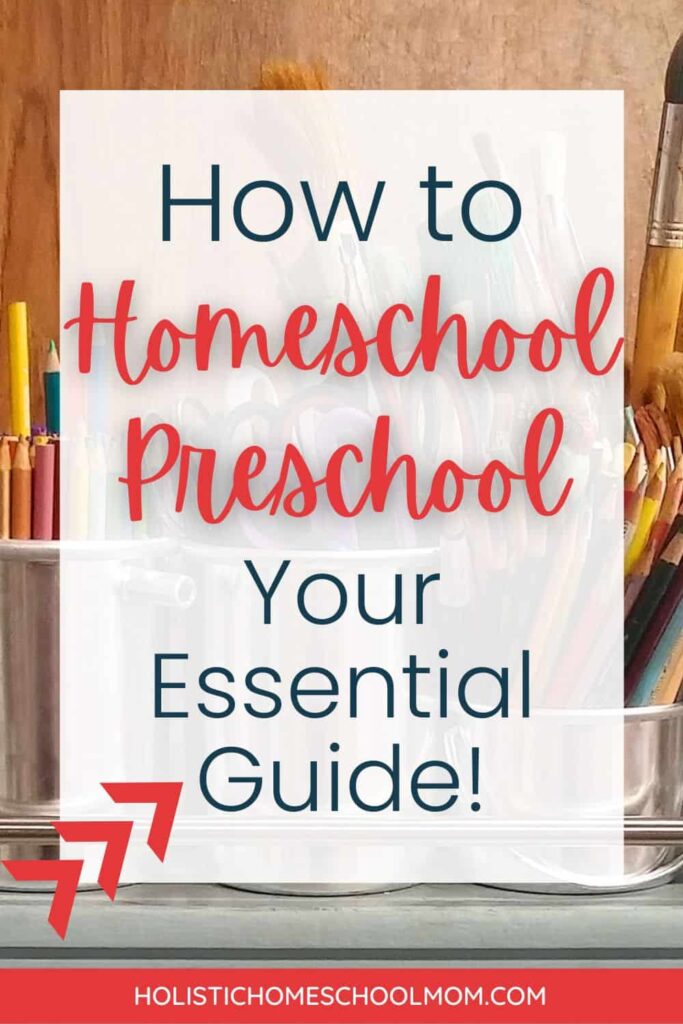
Can I Homeschool Preschool for Free?
With the cost of everything on the rise, this is an important and common question for parents. I absolutely believe you can homeschool preschool for free!
Yes, you will find many curriculums, printables, workbooks, and programs for purchase that are specifically for preschool learning. If you want to buy something, go for it! However, don’t feel like that’s a requirement.
For example, I typically purchased one inexpensive pre-K workbook for fun. I didn’t stress about completing it, or require it every day. Some of these are engaging with colorful pictures, so if your child enjoys them, feel free to include them in your daily routine.
Besides this one purchased resource, however, I primarily used free resources to guide our homeschool preschool learning. There are several options available, but the primary three I used were Easy Peasy All-in-One Homeschool Preschool, Ambleside Online, and Kahn Academy Kids.
Homeschool Preschool With Easy Peasy All-in-One Homeschool
With my now 7-year-old daughter, I used the simple and fun Easy Peasy Preschool. This program is straightforward and completely free! I printed the free worksheets at home and compiled them into a personalized binder for her. We completed one lesson a day. Daily lessons contain a variety of learning activities that vary each day, including video, story excerpts and games.
Overall, each daily lesson took approximately 30 minutes or less. It was low-key and fun, and I would definitely recommend it. This wasn’t all we did for preschool, however.
In addition to this program, I included other learning activities, like those outlined throughout this article, and lots and lots of books!
Homeschool Preschool With Ambleside Online
Ambleside Online (AO) is another excellent resource to guide your homeschool preschool. This is what I followed when I first started learning about homeschooling years ago. The Charlotte Mason approach to homeschooling guided the way I homeschooled preschool, and continues to influence our homeschool.
You can find an overview of that perspective on preschool, as well as a booklist, schedule, and activity suggestions at Ambleside Online.
The website lists Year 0 (K) as “all the years before formal academics begin in Year 1 (typically on or after age 6).” That being said, I used the ideas and perspectives I found there to inform my approach to preschool as well as kindergarten.
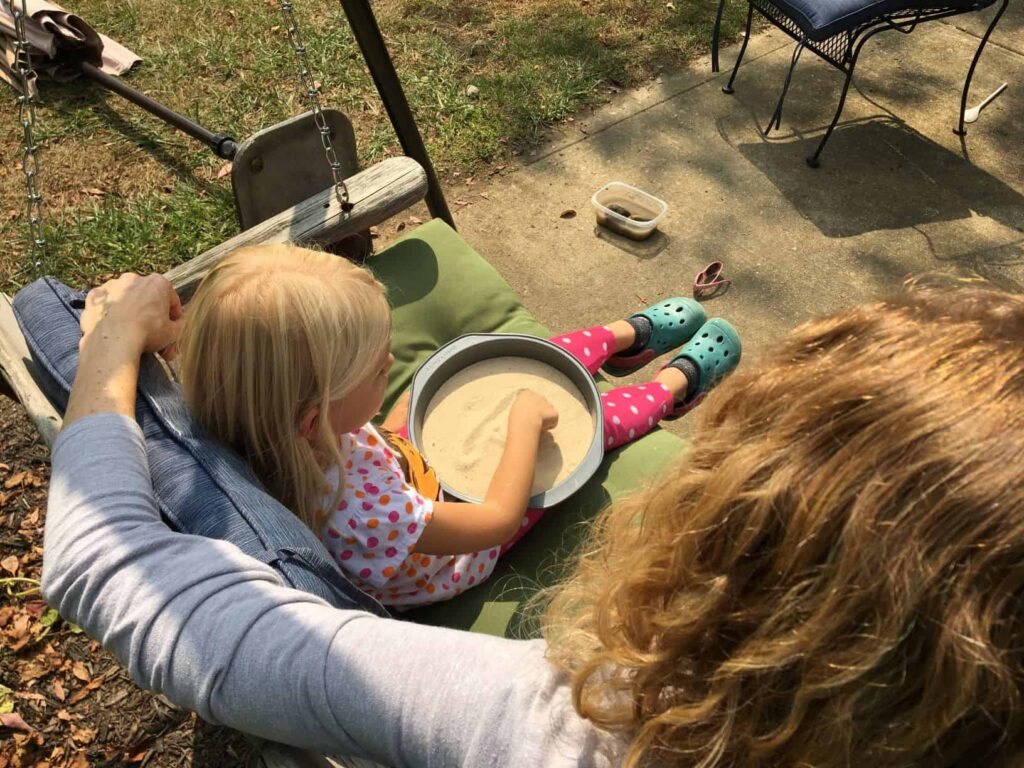
What I love about following Ambleside Online’s suggestions for the preschool years is the simplicity of it. With recommendations of plenty of outdoor play, beautiful books, and gentle introduction to learning through play activities, you’ll be off to a beautiful homeschool journey.
Once you familiarize yourself with the Charlotte Mason approach to homeschooling, you’ll feel confident that this method is absolutely preparing your child for more formal education in the coming years.
(Read more about How to Homeschool With Ambleside Online)
Homeschool Preschool With Kahn Academy Kids
Another free option I utilized from time-to-time, in conjunction with Easy Peasy Preschool, was Kahn Academy Kids. This free app for kids ages 2-8 uses learning games, songs, and stories, and my daughter absolutely loved it.
There’s an adaptive learning path which automatically selects activities for your child when they log in and click their avatar. Or, you can select activities from various categories individually.
After completion, each activity is marked with a green checkmark. Your child can earn various prizes as they progress. We used this program most days out of the week, for about 15-20 minutes.
Self-Care While You Homeschool Preschool
Homeschooling preschool, while rewarding, is challenging at times. As a homeschool mom, it’s crucial to take care of yourself during these years. Homeschooling can be demanding, and it’s essential to prioritize and make time for self-care.
Find time for activities that rejuvenate you, whether it’s reading a book, taking a walk, stretching, or connecting with other homeschoolers for support and encouragement.

Encouragement for the Preschool Homeschool Mom
Whew! I hope this essential guide on how to homeschool preschool has provided you with plenty of facts, tips, and advice to help you launch your homeschool journey confidently!
My last bit of advice? Enjoy the journey!
Homeschooling preschool is such a special time. You’ll experience the wonder and curiosity your child has about the world. They love to explore and learning is such a natural part of life at this age. You also get a front row seat to their growth, and play a major role in what they’re learning each and every day.
I understand that homeschooling preschool may seem daunting at first. It’s normal to feel unsure that you’re doing all the things. Just remember you don’t have to do it all (whatever “all” may be).
You are well-equipped to provide your child with the learning experiences they need. Trust yourself and enjoy this incredible adventure together. You’ve got this, homeschool mom!
Conclusion
I hope you can now confidently say “It IS possible to homeschool preschool!” There are so many resources at your fingertips. You can do this simply, easily and confidently.
Have more questions or comments about homeschooling preschool? I’m happy to help! Please leave a comment below and let me know how I can help.




